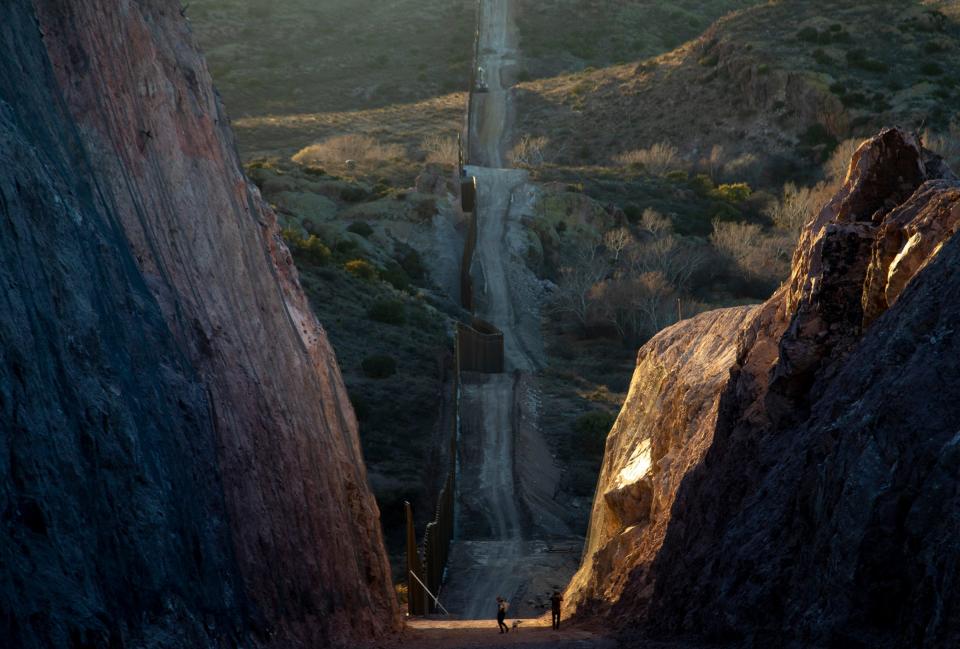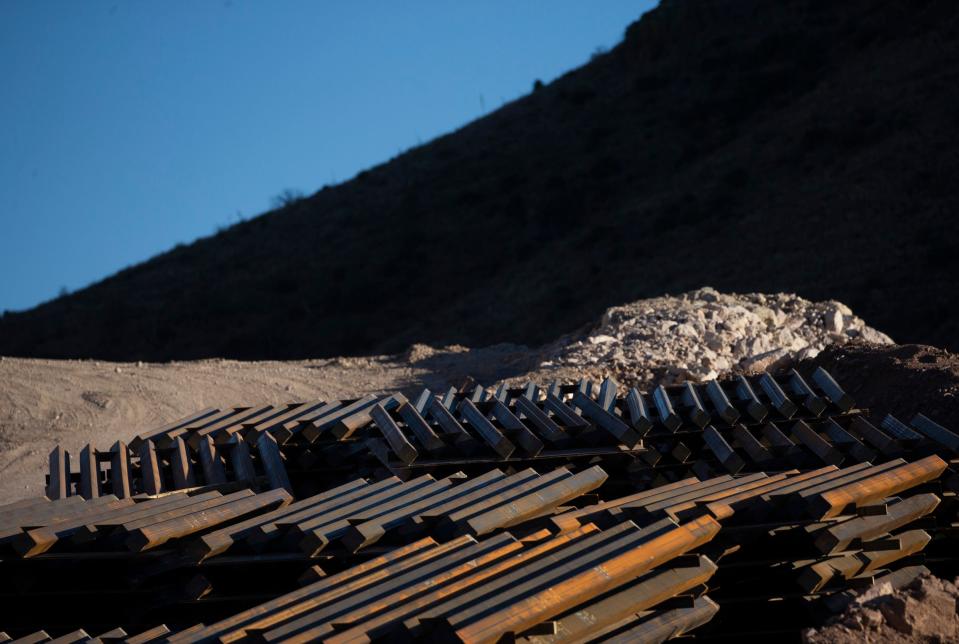Feds OK work to close border wall 'gaps' in Arizona as environmentalists raise concerns

The U.S. government has authorized work to complete unfinished construction, fill border wall "gaps" in Arizona and address "environmental requirements" along the international boundary.
Work is expected to begin more than 11 months since operations were paused by the Biden administration.
It is unclear whether this effort will effectively complete all previously planned fencing throughout Arizona.
The announcement raised new concerns for environmental activists and conservationists, since closing remaining gaps could further affect the future of wildlife whose territory crosses international boundaries.
The announcement, made by the Department of Homeland Security on Dec. 20, authorized U.S. Customs and Border Protection to continue construction activities and "remediation requirements" in unfinished sections of the new border wall in Arizona, California and Texas.
Some of the work involves "closing construction access gaps" in the Tucson, El Paso and Yuma Border Patrol sectors "to address safety concerns." Other activities will involve flood and erosion prevention.
Only 18 miles of former President Donald Trump's border wall project remained incomplete in Arizona by January 2021, according to a CBP spokesperson at the time.
Customs and Border Protection officials did not respond to The Arizona Republic's request for details about construction activities expected in the Tucson and Yuma sectors.
Today, fencing stretches almost all along the Arizona-Mexico border. From 2017 to 2021, approximately 226 miles of 30-foot bollard fencing went up on federal lands in Arizona. The Trump administration's promise was to build more than 450 miles along the 2,000-mile U.S.-Mexico border.
Some of the other miles of border fencing date to previous administrations, and in some places — like within the Tohono O'odham and Cocopah reservations — the border is divided only by vehicle barriers.
The authorization to finish border barrier work comes nearly eight months after Homeland Security announced it would take the necessary steps to address the risks left by the border wall construction.
The U.S. Army Corps of Engineers started some remediation and worksite cleanup activities in the Yuma Border Patrol Sector in July.
The Department of Defense is to turn over the unfinished projects to Homeland Security so it can proceed with the activities. These include, but are not limited to, installing drainage, erosion control and stability structures, disposing materials, building access and patrol roads and adding floodgates.
Homeland Security didn't specify what are the priority areas for completing work on other sites of the border barrier project nor when operations are expected to start.

Barriers can be a 'kill shot' to wildlife
Customs and Border Protection will be in charge of completing or installing drainage and erosion control structures to "address life, safety, environmental, and remediation requirements," the Homeland Security news release said.
Over the four years of border barrier replacement or installations in the U.S. Southwest, mountain ranges were blasted to erect new fencing and to build patrol and access roads on remote, rugged terrain. Some areas that used to have only vehicle barriers were replaced with steel bollards with a separation of 4 inches, where barely a rabbit can get through.
Scientists, environmental activists and tribal leaders have condemned the construction of the new 30-foot tall fencing in ecologically and culturally sensitive areas. Mountains and tribal burial sites were blasted.
Conservation experts and wildlife scientists warn that the new fencing will affect the connectivity of natural areas and the survival of endangered species in the borderlands.
In July 2018, more than 2,500 scientists around the world endorsed a research paper revealing that "a continuous border wall could disconnect more than 34% of US nonflying native terrestrial and freshwater animal species" and in some cases "elevate their risk of extirpation within the United States."
They urged political leaders to consider wildlife when designing strategies to enforce border security.
A continuous 30-foot tall wall would separate species that rely on water resources, prey, foraging and reproductive areas located in both Mexico and the U.S.
"We've got the baseline of what's been done," said Myles Traphagen, borderlands program coordinator for Wildlands Network, who mapped the state of the border wall project in Arizona and New Mexico up to April. "We're definitely tracking this very closely to see how much more wall is added."
Sections of 30-foot tall fencing go continuously for 70 miles in one of the most biodiverse regions in the American Southwest, Traphagen said.
The few unfenced stretches are the only thing that brings hope to wildlife experts for the conservation of some animal populations. These swaths of land sustain a remnant of connectivity, a critical aspect for healthy ecosystems.
"Some of these (border barrier) projects stopped just short of impacting some of the most sensitive areas," Traphagen said.
In western Arizona, within the Cabeza Prieta Wildlife Refuge, a seven-mile gap is the only access for a population of desert bighorn sheep to reach water.
“If they finish the wall on that stretch it would be a kill shot, because they would be sealing that area completely,” said Federico Godínez Leal, former director of the Pinacate and Gran Desierto de Altar biosphere reserve — one of the most biodiverse arid landscapes in Mexico, neighboring north with Organ Pipe Cactus National Monument and Cabeza Prieta refuge.
In 2020, working with local landowners and Mexican conservation authorities, Godínez installed four water reservoirs in El Pinacate as an urgent measure to save wildlife. The drought that year was severe. Desert bighorn sheep, an endangered species with special protection in Mexico, depended on the springs located about a half-mile north into the U.S. — now off limits because of the new border wall.
Godínez said closing that last gap would mean "death row" for that population of bighorn sheep and many more wildlife, and the construction of any extra fencing should be impeded.
There are also water resources south of the border, in Mexico, that wildlife rely on.
"With the exchanges of wildlife, it doesn't matter whether it's north or south," Traphagen said. "There's no political boundary here; the animals operate within bioregions."
In February, a coalition of 70 organizations sent a letter to the White House calling the Biden administration to take action in effectively canceling border wall contracts, restoring land and removing sections of built wall in areas where it interferes with wildlife movements, natural water flows and indigenous pilgrimage traditions.
The group identified ten priority areas from Yuma to Cochise County. These include Las Playas-Pinta Sands and the Sonoran Pronghorn Corridor in Cabeza Prieta National Wildlife Refuge, Quitobaquito Springs in Organ Pipe Cactus National Monument, the Pajarita Wilderness Area, San Pedro and Santa Cruz Rivers, San Bernardino National Wildlife Refuge and the Peloncillo Mountains.
For subscribers: New resource center aids migrants in border city of Sonoyta, Sonora
Flooding hazards remain
For almost a century, border infrastructure has caused serious flooding along the U.S-Mexico border. The dynamics of floodplains and the flow of rivers, zigzagging across the political boundary, has changed as fences go up.
The announcement of Homeland Security would allow Customs and Border Protection to install floodgates where they are missing and build drainage structures.
Many of the effects of fencing are known, but there is still some uncertainty about how newly fenced areas will respond under intense rainfall.
In 1932, flash floods in the border cities of Nogales toppled the border wall, causing about $20,000 in damages at the time. In 2008, the damage was of $8 million. More than 550 houses and business in Mexico were inundated because of a five-foot concrete wall that U.S. Border Patrol placed inside a tunnel that the International Boundary and Water Commission had built to improve drainage and prevent flooding.
In Organ Pipe Cactus National Monument, poorly planned fencing led to the border fence to be knocked over by floods in 2008 and 2011.
This year, during the monsoon rains, several border-wall gates were ripped off from their hinges.
U.S. Border Patrol "open the gates or grates at water crossings based on forecasted weather, field observations, and based on coordination with communities and landowners/ranchers in the area," a Customs and Border Protection spokesperson told The Republic earlier this year.
However, a delayed response caused severe flooding and property destruction in Nogales, Arizona, in 2014.
Along the newly built border fence, some floodgates are missing, some are wide open and some were welded shut last year.
In the Guadalupe Canyon, only time will tell what the impact of the border wall will be on flooding patterns, said José Manuel Pérez Cantú, manager of Cuenca los Ojos, a 121,000-acre privately protected area in Mexico bordering eastern Arizona.
Guadalupe Canyon, within Cochise County, was one of the regions more severely affected. Crews blasted the cliff sides only to make way for construction trucks.

In May, U.S. Sens. Mark Kelly and Kyrsten Sinema of Arizona wrote to the Homeland Security secretary expressing concern about the "alarming environmental conditions created by border wall construction" in Guadalupe Canyon.
As natural dams were removed and topography changed irremediably, ranchers and property owners in Arizona grew concerned of erosion and flood damage. The senators urged that restoration plans be done only after consulting local stakeholders.
Cuenca los Ojos, which is in Mexico, generally is not consulted, but all border barrier activities affect the work it does. For decades, the nonprofit has worked to preserve wildlands connectivity and biodiversity and restore watersheds in the borderlands.
Its property starts about seven miles west of the Peloncillo Mountains in Arizona.
Through tracks on the ground and images on wildlife cameras placed near the border, ranchers and wildlife scientists have seen animals that used to move freely across hundreds of acres walk for miles right along the border wall, Pérez said.
In November, maps from the U.S. Fish and Wildlife Service showed a Mexican gray wolf heading south to the border wall in New Mexico and pacing 23 miles along the fence before going back north.
"The damage is done, and it will take a very long time for it to heal," Pérez said. "People are crossing one way or another, but fauna is completely affected."
Border security: Drugs, crossings on the rise
Drug seizures and the number of migrants crossing illegally through the U.S. southwestern border have continued to rise in recent years.
In fiscal year 2021, agents encountered 1.7 times more migrants crossing the border illegally than in 2019.
The volume of fentanyl going across the southern border is at a record high. In November 2021, agents and officers seized 1,113 pounds, compared with 189 pounds in November 2019.
In November this year, 96% of all fentanyl was seized at ports of entry by CBP’s Office of Field Operations. Only 4% was seized by Border Patrol agents. For all drugs, Border Patrol seized about 10% of the total in November.
Traphagen believes the border barrier projects only serve as a political platform and are short-sighted when trying to solve complex trafficking and migration issues.
“The simplistic chant of ‘Build the wall’ doesn't address the complex nuances of the border,” he said.
In the Dec. 20 announcement, Homeland Security declared that Customs and Border Protection will work closely with landowners, tribal, state and local elected officials, and federal agencies to assess border barrier projects and continue construction and remediation requirements.
Traphagen hasn't heard of any organizations in the coalition being contacted about the resumption of border project activities. But all the local expertise could improve border security while conserving vital habitat and resources, he said.
He remains skeptical whether government officials will listen.
"I don't expect that anybody on the ground will be able to have any input," he said.
Have news tips or story ideas about the Arizona-Sonora borderlands? Reach the reporter at cmigoya@arizonarepublic.com or send a direct message in Twitter to @ClaraMigoya.
Support local journalism. Subscribe to azcentral.com today.
This article originally appeared on Arizona Republic: Feds OK closing Arizona border wall 'gaps,' upgrading flood prevention

